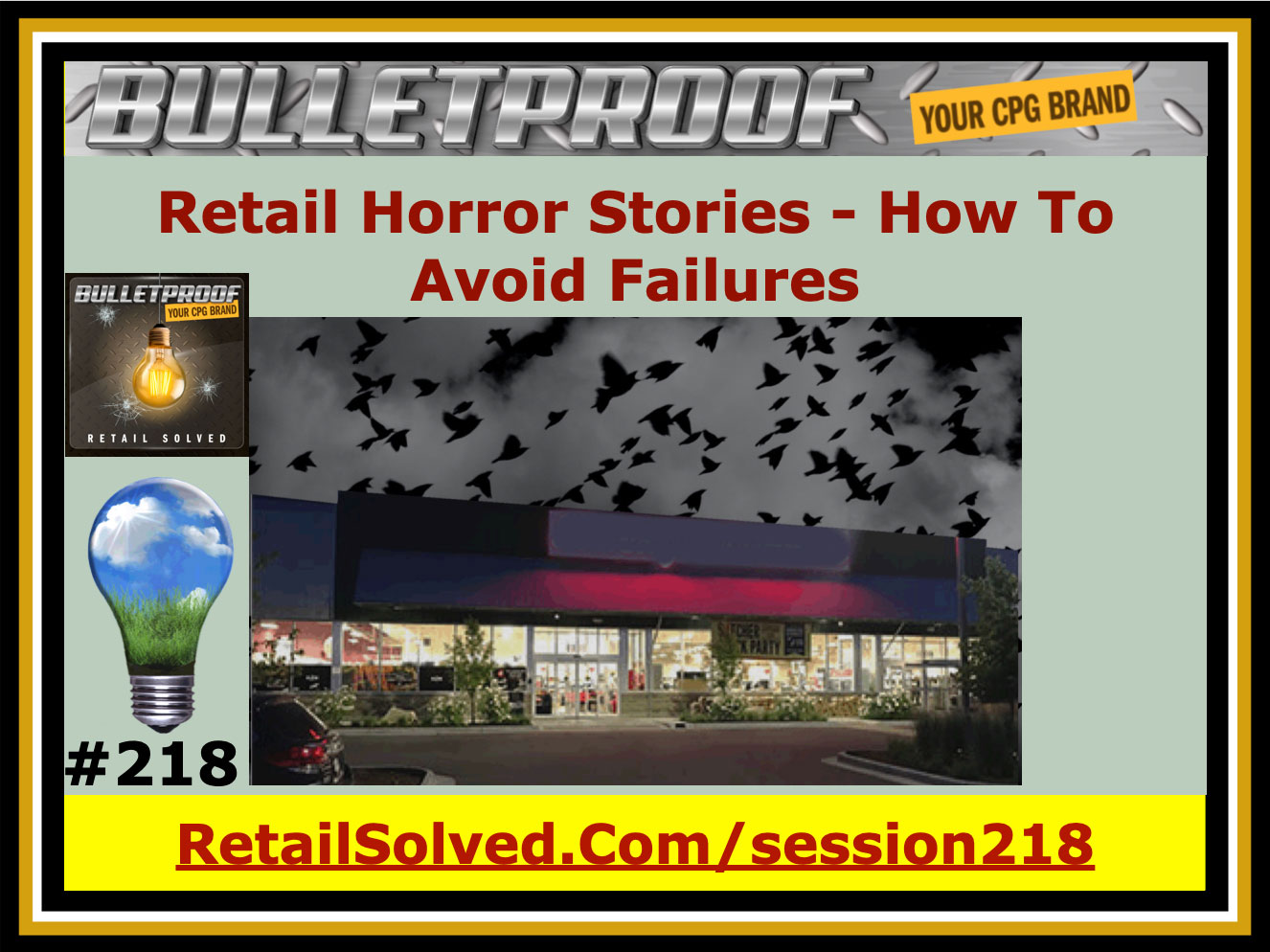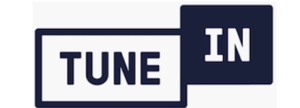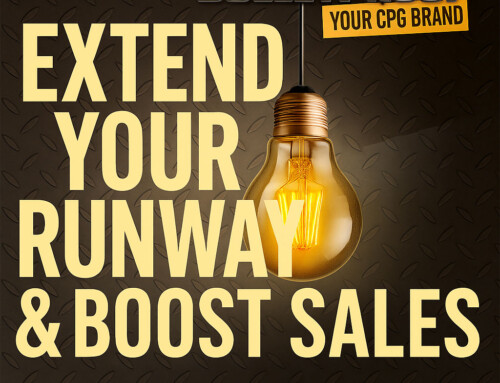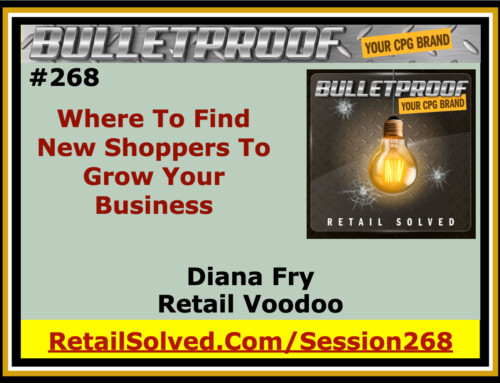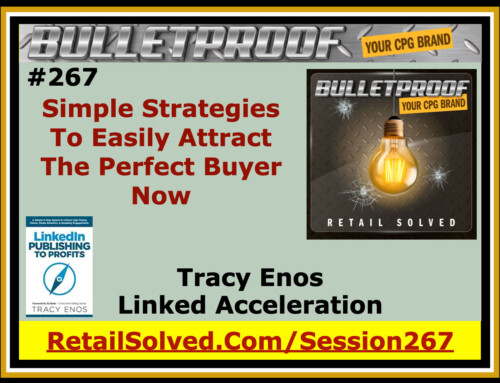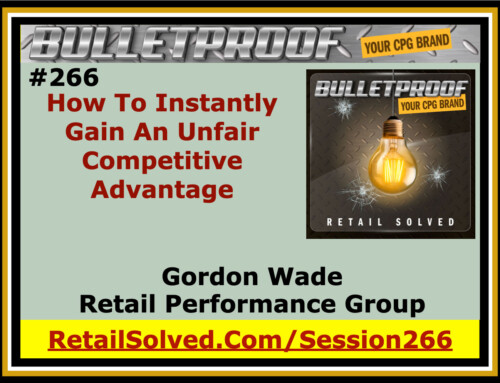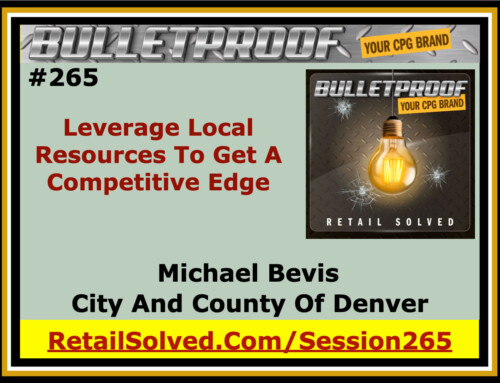Explore Retail Horror Stories – How To Avoid Problems That Derail Brands and learn from real-life marketing failures. Distributors should be strategically chosen to ensure products are placed in stores where the target customers shop. Brands should own their go-to-market strategy and have a robust business plan to guide growth and distribution.
Listen where you get your podcast
Important: Brand Secrets and Strategies has been rebranded to Retail Solved. Please swap all BrandSecretsandStrategies.com URL’s with RetailSolved.com. This is now the Bulletproof Your Brand podcast. Thank you for listening! All brands struggle and go through growing pains, even established big brands. Hear about real-life brand marketing & execution failures. Learn how to avoid the pitfalls & dangers to give your brand a significant sustainable competitive advantage. Today, I'm going to do something a little bit different. To give a nod to Halloween and have a little bit of fun with it, today I'm going to share with you some of the retail horror stories that BRAND SECRETS shared with me over the last 217 episodes. Can you believe it? 217 episodes. But more importantly, we're going to talk about the solution to those problems so that you can avoid those problems altogether. And where most horror stories are designed to keep you up at night, this show, along with all the podcast episodes, are designed to help you get a good night's sleep. The focus is on teaching you what you need to know to confidently grow and scale your brand and to give you an equal seat at the retail table with your most sophisticated competitor. That's exactly why my mission is to help you get your products onto more store shelves and into the hands of more shoppers, including online. Let's start the show. Welcome. I want to begin this episode by saying thank you, by thanking you for listening to this show and for sharing it with your friends. The show is growing in popularity and I really appreciate your helping me raise the bar in the industry. I also want to thank you for sending me the biggest challenges that you have, the biggest bottlenecks you have, and giving me an opportunity to bring the experts, the very best experts in the industry on the weekly webinar series and on the podcast to help solve those challenges. So what do I mean by that if you're new to this? I leaned in after Expo West was canceled and I launched a free weekly webinar series to answer and address the challenges that you share with me. For a complete list of the webinars, including future events and replays, go to the events page on my website. And you can see the complete list of podcast episodes and guest and show topics on the podcast tab. So check it out. And don't forget to go back and listen to previous episodes where I might solve some of your most pressing bottlenecks. Just a quick heads up. I'm going to expand the webinar series to start addressing some of the more general business questions that you have. That's right, bringing in accountants and lawyers and other people that are going to help you solve those problems. You know those things that if you didn't get it right at the very beginning, they're causing you a lot of headaches today. This is something you're going to want to check out because this is going to help give you the healthy foundation to grow and scale in 2021 and beyond. After all, all the information that we've shared thus far on the podcast, on the webinar and the YouTube channels in the courses, are focused on helping you get your brand under more store shelves and into the hands of more shoppers. Addressing the key questions around setting up your business properly, about making sure you've got the right foundation, is going to help future proof your business even more. So please reach out to me and let me know what are the biggest challenges that you face? What are the things that you need to make sure that you're doing right? And I'll work to find the very best experts to help solve your specific challenges. As always, this show is about you and it's for you. If you like this show, do me a favor and share it with a friend. And subscribe so you'll be the first to get new brand building content as soon as it becomes available. As you know, I always give you one free download at the end of every podcast episode. This week, I'm going to give you a tool, a really cool tool that I built. A tool that could help you dramatically give you more runway to build sales. A tool that could dramatically reduce your expenses and give you a significant competitive edge. Now, obviously, I can't promise anything, but what I can tell you is that the more effective you are in managing your trade marketing ROI, the more effective you're going to be at accomplishing each one of those goals. So let me start by saying that the tools that help you manage your trade promotions, they're just essentially quick books for trade marketing. While they help you manage how much money you're spending on one promotion versus another promotion, they don't help you optimize your promotions to the degree that you need to. So obviously, there's a lot more to this. So do yourself and your company a big favor and go to the free promotion analysis tool button on my website and look at the short video to see how much money you could be saving by optimizing your promotions. You're going to be shocked and you're going to be impressed at what you can do even as a small brand. And remember, every slight improvement gives you more runway to grow and scale. Every slight improvement makes your brand more valuable to investors And every slight improvement makes your brand more valuable to retailers. It makes it easier for them to say yes to anything that you recommend. For example, creative strategies to help them grow sales by leveraging the strength of the unique consumer that your brand attracts. Take advantage of this amazing free resource. This is just my way of giving back. And the best part is, you can do before and after scenario and then send them to yourself, email them to yourself for free. This is the best and the most effective way for you to learn what things matter most. What things affect your promotions and what things really drive sales after the promotion is over. Okay, are you ready for the scary stuff? Make sure that you are close to someone that you can grab, just in case you need it. In podcast episode 179, Eric Skay shared a story about a distributor issue that he had. Now I've heard stories like this, although not this egregious. His wife had good news and bad news. The good news is that they sold a truckload of product, $19,000. The bad news was, they received a check for $12.34 Like I said, this is a little bit extreme, but I hear stories similar to this all the time. For example, at Expo West last time we had it, I was talking to one of the brands that had been on the podcast. Her eyes welled up with tears as she started to tell me that they didn't know if they were going to be in business tomorrow because the distributor that they were using was holding on to their cash. In other words, they weren't getting paid in a timely manner. They had bills to pay, and because they were at the mercy of the distributor, they didn't know what they were going to do to keep the lights on tomorrow and the day after. So what's the solution to these problems? Well, I gotta be honest with you, it is so painful to listen to brands talk about what's going on with their distributors. In fact, just recently one of the distributors bragged about having one of their best quarters ever during a pandemic while brands are struggling. And a couple years ago, I was at a networking event for natural brands where the CEO for the same distributor looked out into the audience and told the brands that were watching, you need to lower your prices so you can sell more product. And this is the same day that he just announced record profits for that distributor. So what's the solution? Well, this goes back to episode 1 where I made the comment that retail is broken. And what I mean by that is that there's so many people and organizations with their hand out. The fact is that natural organic products do cost a little bit more. But it's the inefficiencies in our supply system that make the products sometimes out of reach. It makes it harder for you to compete more effectively. This is why my advice, my solution here is that you need to really understand your business. You first need to understand who your customer is, how your customer shops, when your customer buys your product, how do they buy other products, and so on. Now I'm not talking about the generic customer. I want you to get to know your customer on a very intimate basis. Get to know what's unique about your customer. Why do they choose your brand over another brand? One of the challenges for natural brands is there isn't a lot of great information about what's unique about your customer, how they shop, and what motivates them to make the decisions that they do. This is why I developed the free Turnkey Sales Store Strategies course, to help you gain the insights that you need to compete more effectively. Let me explain. A lot of the solution providers think of the Lo-Haas consumer as someone who eats a couple salads and goes for a walk. Well, in our world, there's a lot more to it than that. It's the consumer that's trying to reduce their carbon footprint, the consumer that's concerned about global climate issues, the consumer that's concerned about waste, especially plastic waste, and so on. My secret sauce is helping brands identify that unique consumer and how that unique consumer buys your product. And when they buy your product, what are the other products they buy? And then developing a story that they can then leverage at retail. The result is giving my clients a sustainable edge. After all, these are the same strategies I used to push around P&G, Frito, and a lot of other big brands back when I worked for Unilever and Kimberly Clark. So that's the first part of the solution. Know your customer. Get to know your customer better than anyone. Be able to leverage the insights that you gained from your customer to be able to leverage at a retail. And then you choose, you decide which stores you need to make sure you have distribution in, to be able to meet the needs of that unique customer. This is the second part of the solution that I'm recommending. You don't want to be in a store where your customer doesn't shop. I'll give an example of what this looks like and why this matters. Years ago, I was helping out an innovative peanut butter. It was $12 a jar, and believe me, it was incredible, it was absolutely worth it. If you're a peanut butter lover, like I am. But the problem is that not everyone can afford to buy a $12 jar of peanut butter. So they went to a retailer and the retailer decided to test them in several stores. The problem is that several of the stores that they tested the product in were not of the same customer that could afford to buy a $12 jar of peanut butter. So guess what? The brand failed to meet the velocity threshold set by the retailer and as a result was not picked up for distribution in other stores. Now this is despite the fact that the product did exceedingly well in stores with more affluent customers. So similar to this story, with a distributor, you need to understand exactly where your customer shops, what they look like and you need to make sure that you are in those stores and in those stores only. And you need to make sure that the distributor doesn't put your product in distribution in stores where your customers don't shop. You've heard me say time and time again that retailers generically don't make anything. What they sell is the space that your product takes up on their shelf. What retailers really want are three things, more customers in their store, a reasonable profit in the category and a competitive advantage in their market. Retailers don't need the same canned reports and strategies that every other brand uses. They need insights, actual insights. This is why they need you to help make it easy for your customers to find and buy your product. And of course, all the other products that they buy when they buy your product. The next part of this solution is you need to make sure that the distributor puts your product only where it has the best chance to sell. Don't allow them to put your product in stores where your customers don't shop. And don't allow them to put your product in stores that you can't support. Here's why this matters. A couple months ago, I was working with a brand that has an amazing product who got distribution. Well, the distributor put the product in Florida, Indiana, and Louisiana. Well, she's in California. There's no way she could properly support the brand in those stores. More importantly, the cost of her product on the shelf is going to be a lot more because of the extra freight. And in addition to that, the distributor came back to her and said, hey, we want to promote your brand. So they wanted her to promote her product in stores that she doesn't have distribution in. What a horrible waste of money. Remember when I said, I gotta be honest with you, what I was really getting at is that several years ago when I started in this industry, I'm dating myself, every big brand used distributors. The reason the big brands don't rely on distributors is because of the inefficiencies, because they add so much cost to the product and they offer very little value in return. In other words, if you're a big enough brand and you can distribute the product to the retailer yourself, that's the best scenario. So the final part of this solution is that when you're working with a distributor, you need to make sure that you understand exactly what they do, what to expect from them, and you need to be able to hold them accountable. Whether you're working with a distributor or a broker, you need to hold them accountable and make sure that they're executing your strategy on your behalf the way that you want it executed. This is why I'm a firm believer that you need to own your strategy, your go-to-market strategy. And this goes back to just about every podcast episode, YouTube video, webinar, etc. where we talk about exactly what you need to do in certain situations to do exactly this. After all, this is your brand. It's got your name on it. The way the consumer views your brand is a reflection of how well you execute itself. Your profitability, your success as a brand is contingent on how well you execute, how innovative your strategies are. I have always said that your go-to-market strategy has to be every bit as innovative and disruptive as the ingredients in your package. The next horror story I am going to talk about is actually more of the solution. In podcast episode 207, I was talking to Michael J. O'Donnell about the importance of having a solid and robust business plan. I believe that your business plan should be so robust and so thorough that anyone could step in and run your business on your behalf and in your absence. It should include your growth plan, your plan for incremental distribution, when you are going to promote, how you are going to promote, how deep you are going to promote, and everything else. When do you need to raise capital? When are you going to expand the line? The reason this matters is because when most brands think about strategies to grow sales, they use cookie cutter strategies, sort of a rinse and repeat strategy. In other words, what they did last year is probably going to work this year, maybe tweak it a little bit. So what's the definition of insanity? Doing the same thing again and again and expecting different results? This is one of the key reasons that most promotions do nothing to grow your sales, or get new customers to try your product. After all, that's the sole reason brands should promote anyhow, is to develop new trials. The point is that most brands are reactionary when it comes to developing promotions. They don't think about strategically what they're trying to accomplish. What makes the most sense to get your brand in front of the most customers? Should you do more demos, more displays, a deeper discount, knowing exactly what combination of promotions work the best to grow sales? That's the key. That's why I built a free trade promotion ROI calculator. Use it. So the horror story behind this, behind this episode, is that a lot of brands, because they don't think strategically, participate in every promotion, every retailer, every broker, every distributor asks them, even if it doesn't make sense for them. What you need to do instead is have a good understanding, a thorough understanding of what works best for your brand. And then you need to be able to go to the retailer and help them understand which things work and which things don't work for your brand. For example, if a retailer came to you and said that they want you to promote five times a year, and after your analysis, you find out that five times a year is not going to do really anything to grow your brand or help the retailer. But instead, you are able to show them that if you promote three times a year, much deeper, leveraging all of your assets, you can do more to drive sales in the category and more to grow your brand at the same time. This is another reason why I would never, ever, ever promote or recommend you promote with a distributor because you have no control over who actually uses the promotion. You want to get paid for performance, meaning that you want to pay the retailer, all retailers, and allowance for exactly what scans through the register. In other words, you want accountability. If you're promoting and you don't have that level of accountability, then you're wasting money. Then it's not going to be an effective promotion that's going to help you grow on scale. It's not going to be an effective promotion that you can evaluate and see what it really did to drive sales long term. So you can probably see the common theme going through this. Everything is tied to trade marketing, retail execution, the basics. These are the things that most brands overlook. We all have a lot of challenges, a lot of distractions in our lives. But when it comes to the business, we need to be laser focused on what's going to help you drive sustainable sales. What do you need to do to reach your long term goals? And then how do you stay focused? How do you stay on track? And this goes back to the business plan. You need to have a robust business plan that includes all the marching orders so that you know exactly what to do. So all you need to do is focus on execution. And when you can do that effectively, then you have the opportunity to be more forward thinking, to be able to take advantage of opportunities that present themselves at the last minute. For example, a retailer is saying, hey, I've got an incremental end cap. Would you like it? Being able to say yes to that, being able to say yes to new innovation, new opportunities, this is how you future proof your brand. This is how you gain a significant and sustainable competitive advantage. This all goes back to retail execution and trade marketing. I'm in the process of putting together a robust soup-to-nuts trade marketing program that's going to help answer all of your questions, anything you want to know about trade marketing. So be on the lookout for it. But in the meantime, a lot of the solo episodes for the free webinar series were actually snippets of the course that I'm teaching that I'm putting together. Leverage these skills so you gain a sustainable and competitive advantage. This is how you confidently grow and scale your brand in 2021 and beyond. If you've got incremental questions, reach out to me.
Enter your name and email address below and I'll send you periodic brand building advice, tips and strategies.
Sign up to receive email updates
FREE Trade Promotion ROI Calculator:
Click Here To Maximize Sales And Profits

Efficient Assortment Strategies
Want To Maximize Sales. Begin With The Right Product Assortment Strategies!
Getting products on retailer shelves and keeping them there is crucial for brand success. Traditional ranking reports overlook important factors like the shoppers your brand attracts, your brands market basket and your brands ability to grow the category. Learn a more effective strategy to grow sales for both you and your retail partner. This is how you stand out on a crowded shelf and maximize shopper engagement.
Image is the property of CMS4CPG LLC, distribution or reproduction is expressively prohibited.
